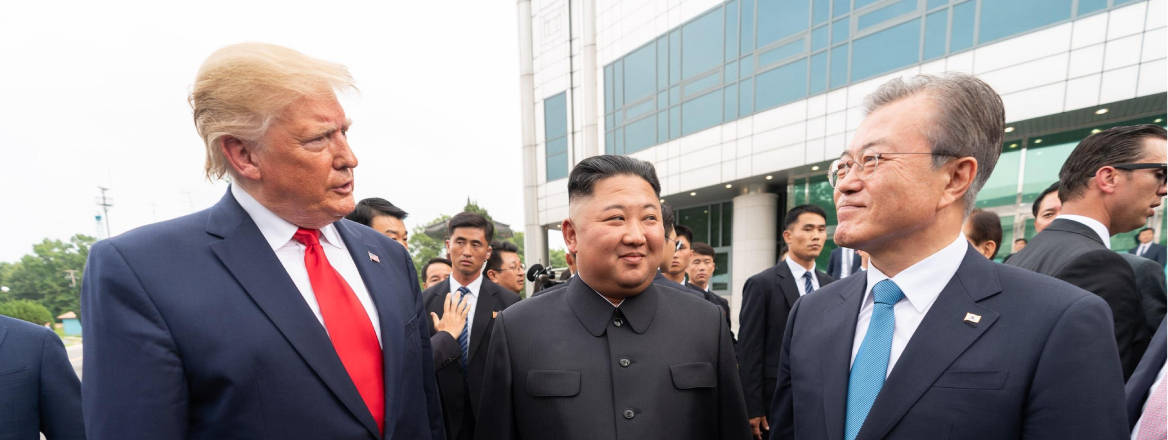What North Korea Is not Telling Us about Denuclearisation in 2020
A new rallying cry to ‘achieve a breakthrough’ has been launched by the North Korean leader. But what this actually means is, probably deliberately, obfuscated.
Notwithstanding renewed active diplomatic efforts since early 2018, the challenge of how to pursue denuclearisation on the Korean peninsula continued to defy solution. Indeed, as last year came to an end, North Korea was expected to raise tensions once again by threatening to deliver a ‘Christmas gift’ to the US which many speculated would come in the shape of a test of an ICBM, or related technology, that would garner more attention than the shorter-range missile tests North Korea conducted during 2019.
A New Rallying Cry?
That did not happen. Instead, the year ended with the unusually timed 5th Plenary Meeting of the 7th Central Committee of the ruling Workers’ Party of Korea (Party Plenum), which may prove to be just as impactful on the future shape of the Washington–Pyongyang relationship. During his speech that concluded the Party Plenum, North Korean leader Kim Jong-un announced a new rhetorical ‘offensive’, ordering the country to make a ‘breakthrough head-on’. The inference is that this was a mobilising appeal to neutralise the sanctions imposed on North Korea and deflect pressure from ‘hostile forces’ by focusing efforts on the economy. But we have no direct clues on this North Korean supposed new direction, or of what might be in store for the future of US–North Korea relations.
The Party Plenum at the end of 2019 saw Kim Jong-un declare that all efforts should be made to ‘advance the revolution’ by achieving a ‘breakthrough’. Since this announcement, state-controlled North Korean media outlets such as Korean Central News Agency (KNCA), the party daily Rodong Sinmun, and the Pyongyang Times have made frequent reference to this new line of propaganda. There have been multiple articles that reiterate this directive, as well as expressing energetic support for it (and, of course, for Kim and his guidance), and widespread reports of efforts to deliver on the appeal.
Such articles have usually referred to the implementation of this new offensive in relation to a range of activities, such as production, industrial development and furthering revolutionary ideology. However, this new party directive provides scant indication of how it will manifest itself in foreign policy, and specifically that which relates to the US, South Korea and broader stability questions on the peninsula. All that can be gleaned from North Korean so far this year is that although Kim continues to have a ‘good personal feelings about Trump��’, the North Korean leader also feels deceived by the US and its approach to dialogue.
Ambiguity in Dealing with the US
This dual-track approach of being gentle to Donald Trump as a person but critical of the US’s conduct of the dialogue generates ambiguity in the North Korean position; Pyongyang may be leaving the door open to the opportunity of further direct engagement with Trump but is not committed to a lower-level engagement process. However, this lack of clarity in regards to engagement with the US on these crucial issues might mean one of two things: the silence could reflect the lack of decision on North Korea’s position on diplomacy and denuclearisation; or it could reflect a decision to withhold announcement of any such new approach (that is, the ambiguity could be a policy in itself).
North Korea may well have made a strategic choice in waiting to communicate its new policy approach until it is ready to showcase the new strategic capability that Kim announced will be demonstrated this year. Thus, a new approach may be part of a broader package of change that will be communicated in a similar timeframe as the revelation of new military capabilities to enhance the credibility of all policy components. The tactic may well be to intentionally keep North Korea watchers – both governments and non-governmental actors alike – guessing, while Pyongyang enhances its nuclear and missile capabilities.
In the past there has been evidence of debate between the senior party officials regarding North Korea’s policy direction. However, evidence of such debate is absent from state media. Given the lack of evidence of internal discussion between the elites on the way forward for US–North Korea relations, the case is stronger for Pyongyang choosing to hold off on communicating its new approach to security and denuclearisation. Of course, alternatives explanations exist, such as the possibility that North Korea elites are using other channels of communication to air their preferences, channels that are not accessible in open information sources. But when considered alongside other actions North Korea has taken, such as replacing experienced diplomat Ri Yong Ho with Ri Son Gwon as foreign minister, the prospects are not that positive: unlike his predecessor, Pyongyang’s new foreign minister has a military background and is thought of as being much less experienced in diplomacy.
At present, we do not have enough data to provide a thorough analysis on whether the lack of communication forms part of a new approach. However, if this deliberate ambiguity does start to become a longer-term trend, insight into North Korean foreign policy may become significantly circumscribed – at least to those who only have access to open sources – and this will result in significantly reduced opportunities for constructive engagement. So, any space that currently exists in favour of engagement will likely become firmly shut for the foreseeable future.
Cristina Varriale is a Research Fellow in the Proliferation and Nuclear Policy group at RUSI.
The views expressed in this Commentary are the authors', and do not represent those of RUSI or any other institution.
WRITTEN BY
Cristina Varriale
RUSI Associate Fellow, Proliferation and Nuclear Policy


